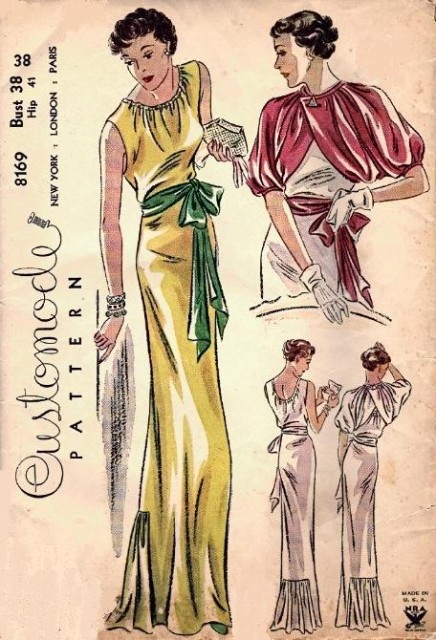WOMEN’S FASHION 1930

WOMEN’S FASHION 1930
In the 1930s there was a return to a more genteel, ladylike appearance. Budding rounded busts and waistline curves were seen and hair became softer and prettier as hair perms improved. Foreheads which had been hidden by cloche hats were revealed and adorned with small plate shaped hats. Clothes were feminine, sweet and tidy by day with a return to real glamour at night.
The French designer Madeleine Vionnet opened her own fashion house in 1912. She devised methods of bias cross cutting during the 1920s using a miniature model. She made popular the halter neck and the cowl neck.

The bias method has often been used to add a flirtatious and elegant quality to clothes. To make a piece of fabric hang and drape in sinuous folds and stretch over the round contours of the body, fabric pattern pieces can be cut not on the straight grain, but at an angle of 45 degrees.
It is sometimes said that Vionnet invented bias cutting, but historical evidence suggests that close fitting gowns and veils of the medieval period were made with cross cut fabrics. The Edwardians also made skirts that swayed to the back by joining a bias edge to a straight grain edge and the result was a pull to the back that formed the trained skirt. She did really popularise it and the resulting clothes are styles we forever associate with movie goddesses and dancers like Ginger Rogers.

Using her technique designers were able to produce magnificent gowns in satins, crepe-de-chines, silks, crepes and chiffons by cross cutting the fabric, creating a flare and fluidity of drapery that other methods could not achieve. Many of the gowns could be slipped over the head and came alive when put on the human form. Some evening garments made women look like Grecian goddesses whilst others made them look like half naked sexy vamps. Certain of her gowns still look quite contemporary.


There was a passion for sunbathing. Women tried to get tans and then show them off under full length backless evening dresses cut on the true cross or bias and which moulded to the body. To show off the styles a slim figure was essential and that was getting easier for women who were educated and aware as many now used contraception and did not have to bear baby after baby unless desired.

The new improved fabrics like rayon had several finishes and gave various effects exploited by designers eager to work with new materials. Cotton was also used by Chanel and suddenly it was considered more than a cheap fabric for work clothes. But nothing cut and looked like pure silk and it was still the best fabric to capture the folds and drapes of thirties couture. Fine wool crepes also moulded to the body and fell into beautiful godets and pleats.
Schiaparelli liked new things as well as new ideas. In 1933 she promoted the fastener we call the zip or zipper. The metal zip had been invented in 1893 and by 1917 it was somewhat timidly used for shoes, tobacco pouches and U.S. Navy windcheater jackets. Her use of the new plastic coloured zip in fashion clothes was both decorative, functional and highly novel. They soon became universally used and are now a very reliable form of fastening.

Health and fitness was an important aspect of thirties lifestyle. As sun worshipping became a common leisure pursuit fashion answered the needs of sun seekers by making chic outfits for the beach and its surrounds. Beach wraps, hold alls, soft hats and knitted bathing suits were all given the designer touch.
Swimwear was getting briefer and the back was scooped out so that women could develop tanned backs to show off at night in the backless and low backed dresses. The colours of the beach holiday were navy, white, cream, grey, black and buff with touches of red.

Pyjamas introduced as informal dinner dress or nightwear for sleeping died quickly as fashions. However the third use of them as a practical beach outfit caught on and every woman made them an essential garment to pack. They were soon regarded as correct seaside wear. The trousers were sailor style, widely flared and flat fronted with buttons. They were made up in draping heavy crepe-de-chine. Blue and white tops or short jackets finished the holiday look.














Reblogged this on a Portia Adams adventure and commented:
This will be useful Fashion Information for Portia I am sure – thanks!
We loved your website so much we added it to http://www.usbhubreview.net/sites-we-like-2. Just fill in the offer and your backlink is permanent.
Yeah, your woman are refined but mine put out. No kidding, here’s Desirae Myerscough http://tinyurl.com/yc7km2
Vern,
Thank you for the comment. I will.
Sincerely
Adriana Sassoon
thanks for sharing some nice pics.
Thank you for sharing your opinion